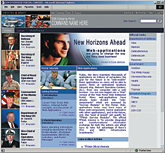Navy chooses portal to assist modernization

When the Navy was trying to select a portal for its servicewide Web initiative, the chief concern was finding a product that wouldn't be difficult to upgrade, modify or replace.
When the Navy was trying to select a portal for its servicewide Web initiative, the chief concern was finding a product that wouldn't be difficult to upgrade, modify or replace.
"We wanted to avoid going down a rabbit hole we couldn't get out of," said Terry Howell, program manager for the Navy's Task Force Web. The team was looking for a program that would be open or flexible enough to connect 360,000 Navy personnel to the thousands of programs they would use daily.
The portal product chosen to serve up these hundreds of thousands of individualized homepages was CleverPath from Computer Associates International Inc., Islandia, N.Y.
For the Navy, being too dependent on individual programs has become a major concern. In October 2000, when Electronic Data Systems Corp., Plano, Texas, began the Navy-Marine Corps Intranet project to network 360,000 Navy desktops, it found tens of thousands of programs, from home-grown financial systems to obsolete word processors, installed across all commands. At last count, the number was 67,000, Howell said.
"A large amount of money goes into developing and maintaining these applications that, from an enterprise level, don't need to exist," Howell said.
So in May 2001, the Navy announced it would streamline its computational environment by deploying servicewide programs that could be accessed through Web browsers.
In January, the task force unrolled a pilot project using 50 enterprisewide applications across 2,000 seats on a Navy carrier and an NMCI network operations center. The task force plans to quickly push the framework out to two full battle groups, one on each coast, by early 2003.
The goal is to complete the rollout by 2004, so that all service personnel will have a single personalized Web home page from which to do their work.
"No matter where someone logs in, they have the required information needed to get the job done from anywhere on the planet," Howell said. Eventually, personal digital assistants and cell phones can be used as well.
To support this environment, the task force designed a Web-services-based architecture that separated Navy computer operations into three distinct layers: data, applications and presentation. This would free the access to data and applications from the platforms on which they were deployed. CleverPath supported the modularity, Howell said.
Many portals are proprietary platforms or based on Web-application servers, said Derek Lacks, a practice director for the Delphi Group, a Boston-based technology research company. CA is one of several companies that offer portals that just provide presentation layer, leaving data and application functions for other programs.
Although CA's CleverPath line has a lot of whiz-bang features, such as predictive analysis and business intelligence reporting, what distinguished it from other choices was the ease with which the task force could tinker and customize the product.
"We were after something we could rip the covers off, get down to show it did its job and how to make modifications. And the CA product was the most open product that we had seen," Howell said.
This flexibility allows the software to operate in a wide variety of conditions. CleverPath must run on multiple platforms, such as the Solaris and HP-UX servers aboard ships, where there is little room for additional servers. It must also work with a wide range of bandwidths.
While the NMCI project promises high-speed data connections, the ships and classified environments that are under the purview of the Space and Naval Warfare Systems Command often operate under more limited circumstances.
"I like to use the analogy that for a ship, we don't have a pipe, we don't have a hose, we don't have a straw, we have a swizzle stick we can use a couple hours a day [to funnel data through]," Howell said.
He said most of the task force engineering team's time is now going into replication and synchronization of these portals across the limited bandwidth conditions of sea-based networks.
For developers, the portal offers a way to publish a list of Web services that were already offered somewhere in the service, eliminating the kind of duplication of efforts that the Navy is trying to lose.
"You could build applications by just putting together Web services," Howell said.
While the Navy moves forward with its ambitious Web enablement, CA's federal unit is rolling CleverPath into larger solutions, said Pete Scalone, area manager for CA's federal systems unit. Recent sales include the Transportation Department and the Federal Aviation Administration.
Of special interest to CA is the burgeoning e-government market. "The capabilities CA offers are totally in-line with the objectives of the president's plans for e-government and the goals set forth by the Office of Management and Budget," Scalone said.
If you have a first-time solution that you recently installed in a government agency, contact Staff Writer Joab Jackson at jjackson@postnewsweektech.com

Pete Scalone, Computer Associate's head of government sales in Reston, Va.

Agency:
Partners
Goal
Obstacle
Solution
Payoff
NEXT STORY: .Net or J2EE? It's a personal thing